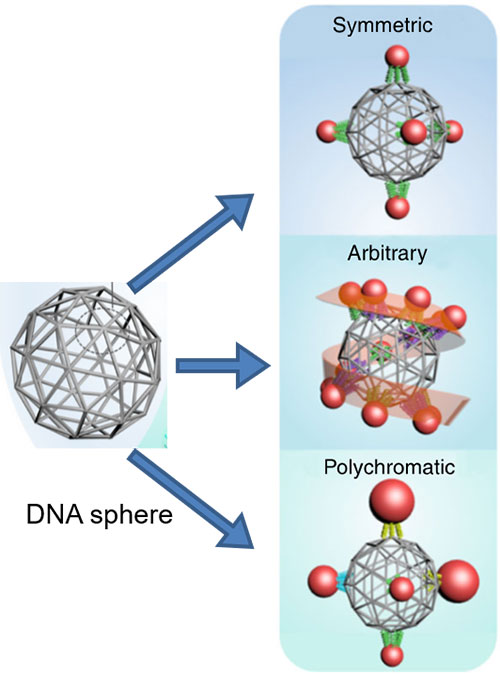Having a Ball Designing Nanoarchitectures with DNA
March 31, 2021
 enlarge
enlarge
DNA spheres provide a universal platform for programming the assembly of symmetric, arbitrary (helical case shown), and heterogeneous cluster architectures. Red spheres represent nanoparticles.
What is the scientific achievement?
CFN researchers created predefined three-dimensional (3D) clusters with complex architectures by programming a sphere-like DNA mesh structure to attach nanoparticles in defined locations. Using this approach, the team programmed the assembly of both symmetric and arbitrary cluster architectures, containing nanoparticles of the same size and different sizes per cluster.
Why does this achievement matter?
Nanoparticle clusters have useful properties for optics, sensing, and information processing, but their precise fabrication by conventional assembly methods is challenging. This work demonstrates that programmable DNA nanostructures provide a universal platform for design and fabrication of cluster architectures with targeted properties.
What are the details?
Nanoparticle-based clusters permit the harvesting of collective and emergent properties, with applications ranging from optics and sensing to information processing and catalysis. However, existing approaches to create such architectures are typically system-specific, limiting designability and fabrication. Our work addresses this challenge by demonstrating that cluster architectures can be rationally formed using components with programmable valence. We realize cluster assemblies by employing a 3D DNA mesh frame with high spatial symmetry as a site-programmable scaffold, which can be prescribed with desired valence modes and affinity types. Using the same underlying frame, we show the realization of a variety of preprogrammed designed valence modes, which allows for assembling 3D clusters with complex architectures. The structures of assembled 3D clusters are verified by electron microcopy (EM) imaging, cryo-EM tomography, and in situ x-ray scattering methods. We also find a close agreement between structural and optical properties of designed chiral architectures.
CFN Capabilities
CFN Materials Synthesis and Characterization and Electron Microscopy Facilities were used for this study, as was the NSLS-II CMS beamline, which is operated in partnership between CFN and NSLS-II.
Publication Reference
S. Sun, S. Yang, H.L. Xin D. Nykypanchuk, M. Liu, H. Zhang, and O. Gang, Valence-programmable nanoparticle architectures, Nature Communications 11, 2279 (2020).
DOI: https://doi.org/10.1038/s41467-020-16157-0
OSTI: https://www.osti.gov/biblio/1690069-valence-programmable-nanoparticle-architectures
Acknowledgement of Support
This work was supported by the US Department of Energy, Office of Basic Energy Sciences, grant DE-SC0008772 (MSE). The research carried out at the Center for Functional Nanomaterials and user resources of National Synchrotron Light Source II at Brookhaven National Laboratory which are supported by US Department of Energy, Office of Science Facility, under Contract No. DE-SC0012704.
2021-18850 | INT/EXT | Newsroom









